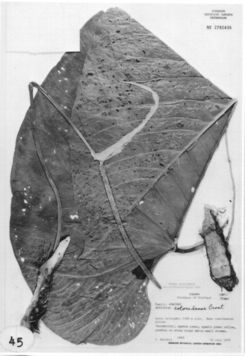



Anthurium coloradense Croat, sp. nov.
TYPE: Panama. Chiriquí: Cerro Colorado, near Continental Divide, 1,500 m, António 1466 (MO 1782436, holotype).
Planta lerrestris; cataphyllum persistens, findins in fibris grossis pallidis; petiolus sulcatus; lamina ovata, modice membranacea, basi profunde cordata, usque 63 cm longa, et 46 cm lata; inflorescentia plus minusve erecta; pedunculus usque 34 cm longus; spatha membranacea, viridis, oblongo-lanceolata, usque 17 cm longa et 1.5 cm lata; spadix luteo-viridis, usque 17 cm longus; baccae ignotae.
Terrestrial; stems moderately short, 2.5-3 cm diam.; the internodes to ca. 3 cm long; cataphylls promptly weathering to coarse, pale fibers.
LEAVES with petioles sulcate adaxially; blades ovate, moderately thin, abruptly acuminate at apex (the acumen narrowly inrolled), deeply lobed at base, to 63 cm long, ca. 46 cm wide, usually broadest in the lower third; anterior lobe to 47 cm long, broadly rounded along the margin, posterior lobes broadly rounded, directed toward the base; sinus spathulate, to 13 cm deep, closed or nearly so; both surfaces weakly glossy on drying, scarcely paler beneath; midrib sharply raised above (dry), raised below; basal veins to 8 pairs, the first to fourth pairs free to the base, the remainder coalesced ca. 2 cm; primary lateral veins to 15 per side, departing the midrib at 55-60¡ angle, gradually arcuate to the collective vein, drying sharply raised above, prominently raised and paler than the surface below; interprimary veins irregular, drying prominulous above, prominent below but much less conspicuous than the primary lateral veins, interconnected to the primary lateral veins by prominent tertiary veins; collective vein arising from the third basal vein, mostly 1-3 mm from the margin, weakly sunken above, prominent beneath.
INFLORESCENCE semierect; peduncle to 34 cm long, ca. 5 mm diam., terete; spathe thin, green, spreading, oblong-lanceolate, to 17 cm long, 1.5 cm wide, broadest near the base, acuminate at apex, acute at the base, decurrent ca. 1.5 cm, inserted at ca. 45¡ angle on peduncle; stipe ca. 4 mm long, 4 mm diam. (dried); spadix yellow-green, gradually tapered, to 17 cm long, to 7 mm diam. near the base, to 3 mm diam. near the apex, held weakly forward at ca. 25¡ angle from the peduncle; flowers rhombic, 3.5-3.8 mm long, 2.2-3.2 mm diam., 5-6 flowers visible in the principal; tepals drying tan, minutely and densely glandular-punctate with a few conspicuous raphide cells, weakly glossy, lateral tepals 2.3-2.5 mm wide, the inner margin broadly rounded, thin; pistils probably weakly exserted; stigma 0.7 mm long, 0.6 mm wide; emergence of stamens not observed.
INFRUCTESCENCE not known. Fig. 45.
Anthurium coloradense is known only from the type collection made in Panama in Chiriquí Province on Cerro Colorado at 1,500 m in premontane rain or lower montane rain forest.
The species is best placed in section Polyneurium and is distinguished by its thin, ovate, relatively veiny blades that dry green, and have the collective vein arising from the third or fourth basal vein, but especially by its narrowly tapered, greenish yellow spadix with five to six flowers visible per spiral. Its leaves are remarkably similar to those of Anthurium caperatum, differing only in having glossier surfaces and in having inconspicuous tertiary veins. However, the inflorescence of A. coloradense diners markedly from A. caperatum, the latter being only slightly tapered to the apex with more than 12 flowers visible in the principal spirals.
Anthurium coloradense is also similar to A. pauciflorum, but that species is markedly smaller in every respect and its tepals lack the conspicuous raphide cells that are characteristic of A. coloradense.

Chiriquí: Cerro Colorado, António 1466 (MO).